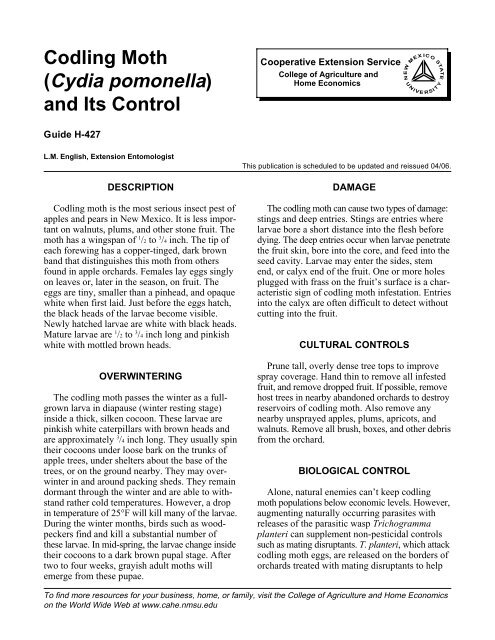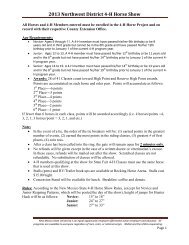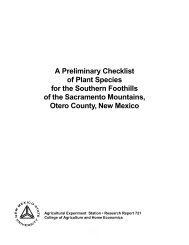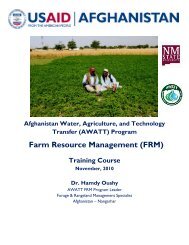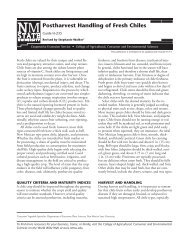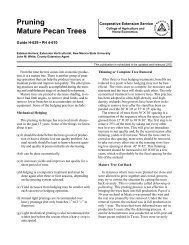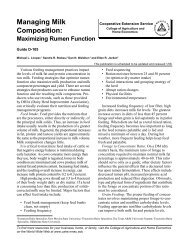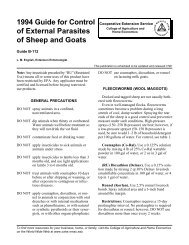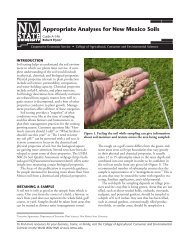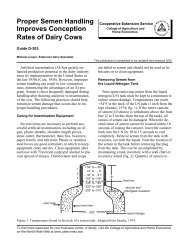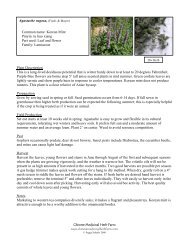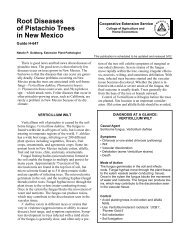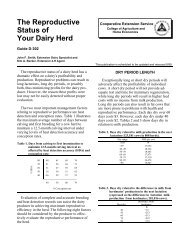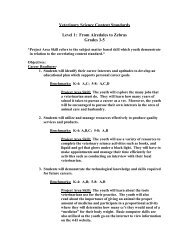Codling Moth (Cydia pomonella) and Its Control - New Mexico State ...
Codling Moth (Cydia pomonella) and Its Control - New Mexico State ...
Codling Moth (Cydia pomonella) and Its Control - New Mexico State ...
You also want an ePaper? Increase the reach of your titles
YUMPU automatically turns print PDFs into web optimized ePapers that Google loves.
<strong>Codling</strong> <strong>Moth</strong>(<strong>Cydia</strong> <strong>pomonella</strong>)<strong>and</strong> <strong>Its</strong> <strong>Control</strong>Cooperative Extension ServiceCollege of Agriculture <strong>and</strong>Home EconomicsN EW MEXU NICOSTAEI V E R SI T YTGuide H-427L.M. English, Extension EntomologistDESCRIPTION<strong>Codling</strong> moth is the most serious insect pest ofapples <strong>and</strong> pears in <strong>New</strong> <strong>Mexico</strong>. It is less importanton walnuts, plums, <strong>and</strong> other stone fruit. Themoth has a wingspan of 1 /2 to 3 /4 inch. The tip ofeach forewing has a copper-tinged, dark brownb<strong>and</strong> that distinguishes this moth from othersfound in apple orchards. Females lay eggs singlyon leaves or, later in the season, on fruit. Theeggs are tiny, smaller than a pinhead, <strong>and</strong> opaquewhite when first laid. Just before the eggs hatch,the black heads of the larvae become visible.<strong>New</strong>ly hatched larvae are white with black heads.Mature larvae are 1 /2 to 3 /4 inch long <strong>and</strong> pinkishwhite with mottled brown heads.OVERWINTERINGThe codling moth passes the winter as a fullgrownlarva in diapause (winter resting stage)inside a thick, silken cocoon. These larvae arepinkish white caterpillars with brown heads <strong>and</strong>are approximately 3 /4 inch long. They usually spintheir cocoons under loose bark on the trunks ofapple trees, under shelters about the base of thetrees, or on the ground nearby. They may overwinterin <strong>and</strong> around packing sheds. They remaindormant through the winter <strong>and</strong> are able to withst<strong>and</strong>rather cold temperatures. However, a dropin temperature of 25°F will kill many of the larvae.During the winter months, birds such as woodpeckersfind <strong>and</strong> kill a substantial number ofthese larvae. In mid-spring, the larvae change insidetheir cocoons to a dark brown pupal stage. Aftertwo to four weeks, grayish adult moths willemerge from these pupae.This publication is scheduled to be updated <strong>and</strong> reissued 04/06.DAMAGEThe codling moth can cause two types of damage:stings <strong>and</strong> deep entries. Stings are entries wherelarvae bore a short distance into the flesh beforedying. The deep entries occur when larvae penetratethe fruit skin, bore into the core, <strong>and</strong> feed into theseed cavity. Larvae may enter the sides, stemend, or calyx end of the fruit. One or more holesplugged with frass on the fruit’s surface is a characteristicsign of codling moth infestation. Entriesinto the calyx are often difficult to detect withoutcutting into the fruit.CULTURAL CONTROLSPrune tall, overly dense tree tops to improvespray coverage. H<strong>and</strong> thin to remove all infestedfruit, <strong>and</strong> remove dropped fruit. If possible, removehost trees in nearby ab<strong>and</strong>oned orchards to destroyreservoirs of codling moth. Also remove anynearby unsprayed apples, plums, apricots, <strong>and</strong>walnuts. Remove all brush, boxes, <strong>and</strong> other debrisfrom the orchard.BIOLOGICAL CONTROLAlone, natural enemies can’t keep codlingmoth populations below economic levels. However,augmenting naturally occurring parasites withreleases of the parasitic wasp Trichogrammaplanteri can supplement non-pesticidal controlssuch as mating disruptants. T. planteri, which attackcodling moth eggs, are released on the borders oforchards treated with mating disruptants to helpTo find more resources for your business, home, or family, visit the College of Agriculture <strong>and</strong> Home Economicson the World Wide Web at www.cahe.nmsu.edu
control eggs laid by mated female moths immigratinginto the area.Timing of the T. planteri releases is very important.They must be released to coincide with codlingmoth egg-laying. Generally this occurs when mothsare consistently caught in traps <strong>and</strong> sunset temperaturesare 62°F or higher. These tiny parasiticwasps are very susceptible to insecticides, so theyshould not be released in areas where broad spectruminsecticides have been used.Biological control in conjunction with matingdisruptants <strong>and</strong> sprays of dormant oils generallyare acceptable organic control methods.MONITORING, MATING DISRUPTION,AND PESTICIDE TREATMENTSPesticide sprays <strong>and</strong> pheromone dispensers todisrupt mating have proven to be effective in codlingmoth control.In orchards treated with pheromone dispensers(mating disruptors), place the dispensers in theupper third of the tree canopy before the firstmoth emergence in mid-March to early April. Asecond application of the pheromone will need tobe made when the first application expires. Thetiming for the second application will depend onthe product. Read the labels closely for applicationintervals. In some years in the most southernportions of the state, a third application may benecessary if the moths are still flying <strong>and</strong> theapples have not yet been harvested. Mating disruptioncontrol programs are most effective when mothpopulations are low <strong>and</strong> in uniform orchards onflat ground.It is important to closely monitor pheromonetreatedfields for damage from codling mothsmoving into the field from neighboring apple,walnut, pear, <strong>and</strong> plum trees. If damage occurs<strong>and</strong> it is necessary to use a pesticide, discontinueany parasite releases for the rest of the season.Growers should use pheromone traps to monitorthe effectiveness of mating disruption treatments.Place the traps in the trees at the same level as thepheromone dispensers to evaluate the developmentof codling moth populations. If the trapcounts become high, the codling moth populationis too high to be effectively controlled with matingdisruption, <strong>and</strong> a pesticide application may benecessary. Monitoring traps should be checkedon a weekly basis <strong>and</strong> the trap lures changed onthe manufacturer’s schedule.In orchards to be treated with insecticides, it isimportant to time applications to kill larvae assoon as possible after they emerge. The optimumtime to treat can be determined by using pheromonetraps, degree-days (DD), <strong>and</strong> twilight temperaturesto monitor codling moth activity <strong>and</strong> determinewhen egg hatch occurs.Soon after bud break, place pheromone trapsin the orchard to monitor for the first moth emergence.Manufacturers generally recommend that traps beplaced on the southeast quadrant of the trap tree<strong>and</strong> 6 to 7 feet high. See table 1 for thresholdlevel of treatments. After the first moths arepresent in the field (the biofix point), you can beginto accumulate degree-days. Once moths areTable 1. Counts of codling moth for thresholds for chemical management.Trap counts* Population levels Comments10 moths/trap/week High Requires heavy insecticide use. If left untreated, heavy damagewill result.3–10 moths/trap/week Moderate Sprays should be applied accurately for each generation.2 moths/trap/week Low Sprays are sometimes unnecessary, but be sure to monitorfruit for damage.*Using the Pherocon 1-CP or one-gallon type trapGuide H-427 • Page 2
consistently present <strong>and</strong> sunset temperatures havereached 62°F, degree-day accumulations may beused to predict egg hatch. The degree-days referredto in this text are based on a lower threshold of50°F <strong>and</strong> an upper threshold of 88°F. Egg layingshould then be verified in the field by checkingleaves <strong>and</strong> fruit for eggs. Consider past-season trapcounts <strong>and</strong> surrounding conditions in determiningwhen to treat.Throughout most of <strong>New</strong> <strong>Mexico</strong>, there aregenerally two to three generations of codlingmoth, with a partial fourth generation occurringonly occasionally in the extreme southern portionof the state. Often there is a lot of overlap fromgeneration to generation. Growers should continueto monitor the overwintering populations <strong>and</strong>later summer generations with traps <strong>and</strong> continueto accumulate degree-days until the crop isharvested or populations decline to below damagingnumbers in September.When using pheromone traps, keep in mindfactors such as tree size, trap density, type of trap,trap placement, br<strong>and</strong> of pheromone, <strong>and</strong> climatebecause these factors may affect the trap counts.Table 1 data may be used as a guideline for economicor spray threshold throughout the growing season.PREDICTING EGG HATCHUsing a codling moth model, it is possible topredict egg hatch in successive generations ofcodling moths. This can be a good tool to timethe first spray with the beginning of egg hatch.Spray should be timed to kill larvae of the firstgenerationhatch 250 to 300 degree-days after thefirst biofix (when the first moth is found inpheromone traps) for moderate to heavy populations,<strong>and</strong> 400 to 500 degree-days for lightpopulations (see table 1). In many orchards itmay be necessary to use more than one spray toadequately control first-generation codling moth,especially if the orchard has a history of codlingmoth infestations. Near the end of the overwinteringgeneration, moth flight trap catches may not bereliable enough to determine the need for anotherspray. To determine if another treatment isneeded, inspect 100 fruit clusters for eggs onleaves, fruit, <strong>and</strong> at cluster bases throughout theupper half of 10 trees. If any eggs or larval entriesare found, treat.In case of a second generation, use pheromonetrap catches to detect an increase in flight activityaround 1060 degree-days from the first biofix.This will signal the start of the next flight ofmoths, or the next biofix. For low to moderatepopulations, a single pesticide application usuallyis sufficient. Make this application 200 to 250degree-days from this second biofix. Underheavy moth populations, one spray is seldomenough, so it will be necessary to make a secondpesticide application. Under these conditions,make the first applications 1050 to 1150 degreedaysfrom the first biofix. The second should bemade when the previous spray’s residual ends.The third generation of codling moth does notoccur in all parts of the state. <strong>Codling</strong> moth larvaenormally go into diapause, or winter dormantstage, during the third week in August. However,in warm years <strong>and</strong> in warm locations, they maystart pupation before this time. These pupae willsoon emerge <strong>and</strong> produce the third generation. Inthese areas, if 650 degree-days have accumulatedbetween the peak of the first generation flight <strong>and</strong>August 22, most of the larvae will not go into anoverwintering stage but will pupate <strong>and</strong> emergeinto the third generation. If this occurs, usepheromone traps to establish a third biofix whenflight activity increases around 1100 to 1200degree-days after the second biofix. Apply aspray when 200 to 250 degree-days accumulatefrom the third biofix.TREATMENTS FOR CONTROLOF CODLING MOTHParasitic wasps, Trichogramma planteri, atthe rate of 100,000 per acre. Release this parasiteto supplement mating disruption treatments. Treatthe entire orchard if codling moth populations aremoderate to high. For low populations, treatingthe orchard border may be adequate. It is necessaryto make weekly releases during the egg-layingperiod.Narrow range oil (Supreme), 1 to 1- 1 /2 gallonsper acre when dry (no visible moisture on leafsurface). Oils are only mildly effective againstcodling moth, so they need to be reapplied frequentlyduring egg hatch. Oils may be phytotoxic if usedwithin a few weeks of a sulfur spray or if appliedat higher rates during hot weather. The best use isGuide H-427 • Page 3
generally to maintain lower populations in matingdisrupted orchards.Mating disruptants (Isomate-C), 400 dispensers/acre.This treatment is most effective on largerblocks of trees of uniform size. It is important toscout the field for other insects (stink bugs, lygusbugs, <strong>and</strong> leafrollers) that are normally controlledby codling moth insecticides.Insecticides labeled for codling moth controlinclude:• Asana• Pounce• Lannate• Javelin• Ambush• Thiodan• Guthion• Sevin*• Imidan• Diazinon**Available to non-licensed pesticide applicators.REFERENCESUniversity of California, IPM Pest ManagementGuidelines, January 1996.Oklahoma <strong>State</strong> University Extension Agents’ H<strong>and</strong>bookof Insects, Plant Disease <strong>and</strong> Weed <strong>Control</strong>,January 1999.Metcalf, Flint, <strong>and</strong> Metcalf. Destructive <strong>and</strong> UsefulInsects, Fourth Edition, McGraw-Hill Book Company,1962.Be sure to read <strong>and</strong> follow all labelinstructions when applying pesticides.<strong>New</strong> <strong>Mexico</strong> <strong>State</strong> University is an equal opportunity/affirmative action employer <strong>and</strong> educator. NMSU <strong>and</strong> the U.S. Department ofAgriculture cooperating.April 2001Guide H-427 • Page 4Las Cruces, NM5C


